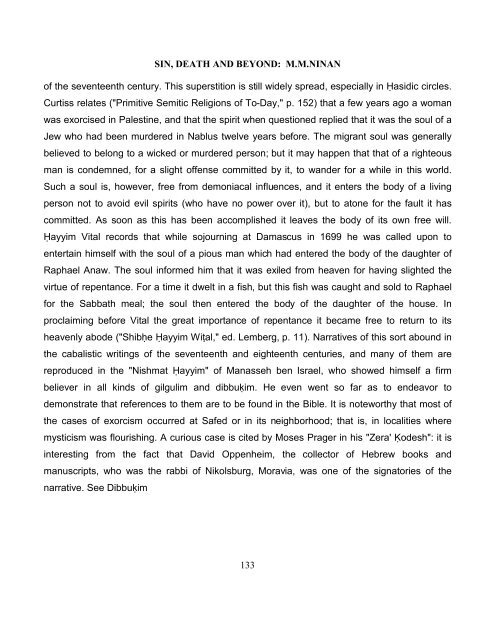Sin death and beyond
Create successful ePaper yourself
Turn your PDF publications into a flip-book with our unique Google optimized e-Paper software.
SIN, DEATH AND BEYOND: M.M.NINAN<br />
of the seventeenth century. This superstition is still widely spread, especially in Ḥasidic circles.<br />
Curtiss relates ("Primitive Semitic Religions of To-Day," p. 152) that a few years ago a woman<br />
was exorcised in Palestine, <strong>and</strong> that the spirit when questioned replied that it was the soul of a<br />
Jew who had been murdered in Nablus twelve years before. The migrant soul was generally<br />
believed to belong to a wicked or murdered person; but it may happen that that of a righteous<br />
man is condemned, for a slight offense committed by it, to w<strong>and</strong>er for a while in this world.<br />
Such a soul is, however, free from demoniacal influences, <strong>and</strong> it enters the body of a living<br />
person not to avoid evil spirits (who have no power over it), but to atone for the fault it has<br />
committed. As soon as this has been accomplished it leaves the body of its own free will.<br />
Ḥayyim Vital records that while sojourning at Damascus in 1699 he was called upon to<br />
entertain himself with the soul of a pious man which had entered the body of the daughter of<br />
Raphael Anaw. The soul informed him that it was exiled from heaven for having slighted the<br />
virtue of repentance. For a time it dwelt in a fish, but this fish was caught <strong>and</strong> sold to Raphael<br />
for the Sabbath meal; the soul then entered the body of the daughter of the house. In<br />
proclaiming before Vital the great importance of repentance it became free to return to its<br />
heavenly abode ("Shibḥe Ḥayyim Wiṭal," ed. Lemberg, p. 11). Narratives of this sort abound in<br />
the cabalistic writings of the seventeenth <strong>and</strong> eighteenth centuries, <strong>and</strong> many of them are<br />
reproduced in the "Nishmat Ḥayyim" of Manasseh ben Israel, who showed himself a firm<br />
believer in all kinds of gilgulim <strong>and</strong> dibbuḳim. He even went so far as to endeavor to<br />
demonstrate that references to them are to be found in the Bible. It is noteworthy that most of<br />
the cases of exorcism occurred at Safed or in its neighborhood; that is, in localities where<br />
mysticism was flourishing. A curious case is cited by Moses Prager in his "Zera' Ḳodesh": it is<br />
interesting from the fact that David Oppenheim, the collector of Hebrew books <strong>and</strong><br />
manuscripts, who was the rabbi of Nikolsburg, Moravia, was one of the signatories of the<br />
narrative. See Dibbuḳim<br />
133


















